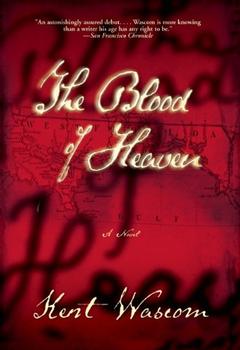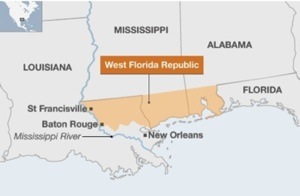Summary | Excerpt | Reviews | Beyond the Book | Read-Alikes | Genres & Themes | Author Bio

Critics' Opinion:
Readers' Opinion:
First Published:
Jun 2013, 432 pages
Paperback:
Jun 2014, 464 pages
 Book Reviewed by:
Book Reviewed by:
Kim Kovacs
Buy This Book
This article relates to The Blood of Heaven
The Blood of Heaven is set primarily in West Florida during the early years of the 19th century. At the time, West Florida occupied part of what is now referred to as the Florida Panhandle, as well as sections of what are now Louisiana, Mississippi and Alabama along the Gulf Coast. It was bordered by the Mississippi River to the west, and the Chattahoochee and Apalachicola Rivers to the East. The northern boundary was less well-defined, advancing into territories held by the Choctaw and Creek Nations.
Spanish colonists first attempted settlement in the mid-16th century, but no permanent outpost was established until 1698 when a fort was built in what would later become Pensacola, Florida. Its purpose was to deter the French from claiming the area, who at the time were exploring southward down the Mississippi River. The territory was never heavily populated by either country's citizens, though, and at the close of the French-Indian War (1754-1763), the French ceded the land east of the Mississippi to the British (although technically they didn't have rights to it). Spain ceded the rest of Florida to them as well, in exchange for Cuba, which the British had captured during the war.
 The British were the first to divide the area into East and West Florida for administrative purposes. They populated it with retired soldiers, to whom they granted prime land as a reward for their services. Immigration also picked up as English loyalists sought to escape persecution in the colonies as anti-British sentiment increased. During the revolution that resulted in the United States (1775-1783), West Florida was unsurprisingly aligned with the British and refused to fight.
The British were the first to divide the area into East and West Florida for administrative purposes. They populated it with retired soldiers, to whom they granted prime land as a reward for their services. Immigration also picked up as English loyalists sought to escape persecution in the colonies as anti-British sentiment increased. During the revolution that resulted in the United States (1775-1783), West Florida was unsurprisingly aligned with the British and refused to fight.
In 1781 Spain joined the war, backing the newly formed United States, and captured Pensacola. Those in residence – which by that time included citizens from the United States, England, France and Spain – were allowed to stay, provided they swore loyalty to the Spanish crown and converted to Catholicism. West Florida continued to be sparsely inhabited, however, and the Gulf Coast provided easy access. According to a 2005 article in The Independent, the area "served as a sanctuary and foraging ground for outlaws, political refugees, military deserters, buccaneers, fortune hunters, and a great variety of misfits and malcontents."
The Louisiana Purchase in 1803 - a large tract of land bought by President Thomas Jefferson from France under Napoleon Bonaparte's leadership - complicated the situation and led to ownership squabbles between the United States and Spain for years afterwards. The United States claimed West Florida as part of this purchase (although the deed was actually only for the land west of the Mississippi River, and therefore the claim wasn't legitimate). The Spanish, not being privy to the actual agreement, argued that the French had no claim to the area and therefore couldn't sell it.
This is where the Kemper brothers, who are the primary protagonists in The Blood of Heaven, enter the historical record. The three siblings – Rueben, Samuel and Nathan – were well known in the area as uncouth, boozing and violent land speculators. They relied on the uncertainty of ownership, as well as the belief that the Jefferson government would back them with military aid, to attempt a revolt against Spanish rule in 1804. The coup attempt, which became known as the Kemper Rebellion, failed miserably because the pro-British, pro-Spanish and pro-French residents refused to join them, preferring the status quo to the uncertainty of absorption into the new United States. The Independent also claims that "[M]any residents recognized that the Kempers and their gang were not so much revolutionaries as opportunistic and unscrupulous marauders mouthing political slogans."
 Over time more individuals from the United States migrated to the area, however, and became increasingly frustrated with Spanish rule of the territory. On July 25, 1810 a group of West Florida settlers met with the Spanish governor to demand reforms - none of which were implemented. Their dissatisfaction led to an armed uprising, resulting in the capture of the Spanish garrison at Baton Rouge on September 23, 1810 and the declaration of the Republic of West Florida as an independent nation.
Over time more individuals from the United States migrated to the area, however, and became increasingly frustrated with Spanish rule of the territory. On July 25, 1810 a group of West Florida settlers met with the Spanish governor to demand reforms - none of which were implemented. Their dissatisfaction led to an armed uprising, resulting in the capture of the Spanish garrison at Baton Rouge on September 23, 1810 and the declaration of the Republic of West Florida as an independent nation.
President James Madison had long eyed West Florida and had continued to maintain it belonged to the United States as part of the Louisiana Purchase. In a politically unpopular move, he annexed West Florida on October 27, 1810 and sent soldiers into Baton Rouge on December 10, making it a part of the Territory of Orleans. The Spanish continued to protest until 1819, when they ceded all of Florida to the United States in exchange for a renunciation of American claims to Texas.
Images:
Top: Map of West Florida Republic in 1810 from bbc.co.uk bbc.co.uk
Bottom: The Bonnie Blue was the official flag of the Republic of West Florida
Filed under Places, Cultures & Identities
![]() This "beyond the book article" relates to The Blood of Heaven. It originally ran in June 2013 and has been updated for the
June 2014 paperback edition.
Go to magazine.
This "beyond the book article" relates to The Blood of Heaven. It originally ran in June 2013 and has been updated for the
June 2014 paperback edition.
Go to magazine.





The Flower Sisters
by Michelle Collins Anderson
From the new Fannie Flagg of the Ozarks, a richly-woven story of family, forgiveness, and reinvention.

The House on Biscayne Bay
by Chanel Cleeton
As death stalks a gothic mansion in Miami, the lives of two women intertwine as the past and present collide.

The Funeral Cryer by Wenyan Lu
Debut novelist Wenyan Lu brings us this witty yet profound story about one woman's midlife reawakening in contemporary rural China.
Your guide toexceptional books
BookBrowse seeks out and recommends the best in contemporary fiction and nonfiction—books that not only engage and entertain but also deepen our understanding of ourselves and the world around us.